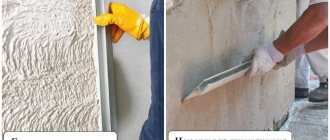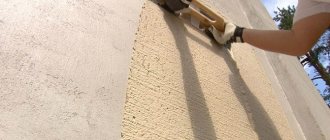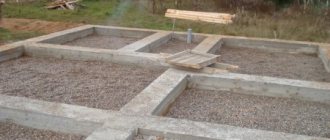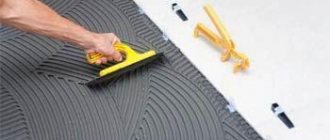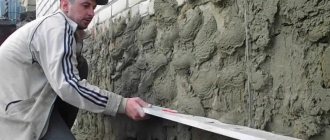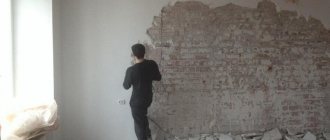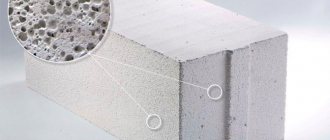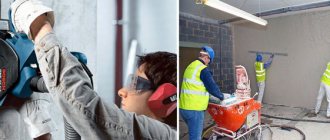Without plastering, it is impossible to obtain perfectly smooth walls - this is an integral stage in finishing the premises. Plaster not only allows you to level the surface, but also significantly improves its strength characteristics.
With its help, various defects are removed from the walls, and when applying a thick layer, their heat and sound insulation improves. But it is worth noting that if you start finishing before the composition dries, numerous cracks will appear, which will lead to premature destruction of the finishing layer. So how long does it take for plaster to dry?
How long does it take for cement plaster to dry?
If we talk about this type of finishing material, then approximately 1 cm layer of plaster dries in 24 hours, but only in ideal temperature conditions. When the humidity in the room is high, this process can drag on indefinitely - cement compositions not only release moisture, but also absorb it well.
To regulate the process, specialists often install special boilers in the room that dry the air. But it is important to choose a place for installation so that all surfaces dry evenly.
Beginning craftsmen should take into account that it is highly undesirable to use fans, since with the rapid evaporation of moisture, the quality of the finish begins to suffer - the plaster cracks and in some places comes off the walls.
It is impossible to give an exact answer as to how long the cement composition will dry - it depends on the temperature and humidity level in the room. But if you know the basic parameters, it’s easy to independently make approximate calculations when you can begin subsequent finishing.
It is better to carry out work using cement compositions in warm, sunny weather, since rain and dampness significantly increase the drying time of the solution.
How to speed up the drying process of the finish?
Very often, beginners begin to putty the surface even before the previous material has completely dried. Such haste leads to irreparable consequences. To avoid such mistakes, you need to correctly calculate the drying time, which is influenced by the following factors:
- the thickness of the applied coating should be about 1.5 cm, but thus not exceed 5 cm. Three days will be enough for such a surface to dry;
- the required time for complete drying of the walls can be reduced to 1-2 days, but with strict adherence to temperature and air humidity;
- You can proceed with further finishing of the walls only if the mass humidity in the layer of plaster does not exceed 8%;
- it is necessary to “knead” the solution correctly and apply it to a less damp surface.
Sometimes there are situations in which it is really necessary to speed up the drying of the plaster mixture. What is better on the walls: wallpaper, painting, plaster? Of course, it’s better not to disrupt this process, but if you really need it, you can use these tricks:
- if possible, reschedule plastering work for the warmer months;
- the room should be heated with “dry” heat (electric heaters are perfect for this, but use this option with caution to avoid cracks in the walls);
- use a plaster mixture that contains gypsum (this material has a “porous” structure that allows air to pass through well and naturally speeds up the drying process);
- provide a good exchange of fresh air.
Optimal conditions for quick drying
During the use of plaster compositions, it was found that a layer 1 cm thick dries out within a day. Even ideal temperature and humidity practically do not change this indicator; a maximum of 2 cm layer can dry out in a day.
In addition, the drying time is affected by the type of plaster, the quality and material of the walls. For example, the most popular and affordable composition: cement, water and sand, dries and gains its strength characteristics within 28 days under ideal conditions. It turns out that if a significant layer of lime-cement composition has been applied, then further finishing can be done after 1 month.
However, a week after plastering with a cement composition, it is already possible to perform basic putty.
When using a gypsum mixture, facing work can begin after 4 days - during this time the plaster layer will completely dry.
When calculating drying time, it is important to consider the thickness of the layer. Experts do not advise applying more than 5 cm at a time - this will not only significantly increase the drying time, but will also not allow you to obtain a durable and high-quality surface.
Optimal drying conditions:
- air humidity up to 70%;
- temperature regime is not higher than +20 degrees.
Based on this, it is worth noting that it is not advisable to start finishing during a hot period, since this will entail rapid weathering of water, which can cause the plaster to crack and begin to move away from the walls.
When the temperature ranges from +5 to +10 degrees, the cement composition can dry for a very long time.
In order to improve the adhesion of the plaster to the walls, and the coating lasts a long time, the following conditions must be observed:
- eliminate drafts;
- refuse to accelerate the process by additional heating;
- protect surfaces from sun exposure;
- do not try to remove moisture from the room by ventilation - opening windows and doors until completely dry is strictly prohibited.
Drying time depends on the following conditions:
- type of plaster;
- wall material;
- thickness of the applied layer;
- weather.
Type of solution
An important factor influencing how long a plastered surface will take to dry is the type of mortar. The most common ones include the following:
Mortar
Lime mortars are characterized by high plasticity. The next layer can be applied after 6-7 hours, and the finished surface is strong and durable. Using a lime composition is an old but proven method. Its popularity in our time can be explained by its low price and ease of operation.
Gypsum plaster
Recently, gypsum plaster has become widespread, allowing you to save on heating costs by creating a good thermal insulation layer. A special feature of the gypsum mixture is the minimum time between application of layers, which ranges from 30 minutes to 2 hours. Gypsum plaster is completely dry five days after all layers have been applied.
Cement plaster
This type of wall plastering is the most popular due to its high performance and ease of application. Due to its density and moisture resistance, cement plaster will take longer to dry, approximately 2-4 days (depending on the base and layer thickness).
Clay-cement mixtures
Such solutions are especially often used for finishing fireplaces and stoves, because they are able to withstand relatively high temperatures. Drying rates and times are similar to those for cement plaster.
USEFUL INFORMATION: How to make stucco on the wall with your own hands?
How to speed up the drying process
There are some techniques that can speed up the drying of plastered walls without negatively affecting the strength of the coating:
- carry out all finishing work in spring or summer;
- mechanical air drying using special devices;
- use of gypsum compositions;
- creating optimal air circulation, avoiding drafts.
If the walls have been recently plastered, then the use of additional artificial drying accelerators is strictly prohibited - the composition must be allowed to set within 24 hours.
If the drying process is delayed, it means there is a high level of humidity in the room and you can install a device for artificial air circulation.
How can you speed up the drying process of plaster?
Artificial drying of plaster is undesirable, as it is fraught with consequences (it can quickly crack). However, there are circumstances when it is necessary to speed up this process. To do this you need to adhere to a number of rules:
Try to carry out wall finishing work in the warm season. It is important to ensure that there is dry heat in the room
You can resort to using electric heaters, but only with extreme caution; cracks may occur on the walls.
is of great importance, it is important to take care of it too. The use of hair dryers, hardeners, and bright lamps is allowed. But to avoid the need for repeated repairs, you must strictly adhere to the instructions for the solution used. Since the gypsum surface dries fastest, preference should be given to this material. Almost always, renovation work in an apartment or private house includes plastering the walls
In some cases, other surfaces of the room, such as the floor and ceiling, also need such treatment. This substance is involved in the leveling process and in additional strengthening of the base material, increasing resistance to aggressive environments. The list goes on and on. Undoubtedly, such an additional layer gives the treated surface an additional level of sound insulation effect. Nothing can replace plaster as a way to deal with major flaws and imperfections in walls. Such problems are often defects such as gouges, cracks, or defects in wall masonry. Like all products whose purpose is construction and repair, plaster mixtures have specific operating characteristics. It is important to have knowledge regarding the requirements for preparing the solution. But, even if you completely follow the instructions, follow the recommendations exactly, you may get a far from ideal result. The most common mistake is not allowing enough time for complete drying. Early application of the subsequent layer of decorative finishing materials. The result will be the appearance of unevenness and cracks. In the worst case scenario, a layer of plaster is sprinkled along with a layer of decor. Therefore, in our article we will look in detail at how long it takes for plaster to dry on walls. It is according to the standards, and not focusing on deceptive self-perceptions. To begin with, let’s remember what the concept of building plaster is.
Almost always, renovation work in an apartment or private house includes plastering the walls. In some cases, other surfaces of the room, such as the floor and ceiling, also need such treatment. This substance is involved in the leveling process and in additional strengthening of the base material, increasing resistance to aggressive environments. The list goes on and on. Undoubtedly, such an additional layer gives the treated surface an additional level of sound insulation effect. Nothing can replace plaster as a way to deal with major flaws and imperfections in walls. Such problems are often defects such as recesses, cracks, or defects in wall masonry. Like all products whose purpose is construction and repair, plaster mixtures have specific operating characteristics
It is important to have knowledge regarding the requirements for preparing the solution. But, even if you completely follow the instructions, follow the recommendations exactly, you may get a far from ideal result.
The most common mistake is not allowing enough time for complete drying. Early application of the subsequent layer of decorative finishing materials. The result will be the appearance of unevenness and cracks. In the worst case scenario, a layer of plaster is sprinkled along with a layer of decor. Therefore, in our article we will look in detail at how long it takes for plaster to dry on walls. It is according to the standards, and not focusing on deceptive self-perceptions. To begin with, let’s remember what the concept of building plaster is.
Related Posts
- How to operate a plastering machine correctly
- Basic properties of putty and plaster: how do these materials differ?
- Bathroom tiles
- How to properly apply decorative plaster with your own hands?
- How to properly plaster walls with your own hands: instructions for beginners (photos & videos) + reviews
- Decorative plaster on the ceiling - features of the material and performance of the work
- Finishing the facade with decorative plaster
- Plastic fastening clips for plaster beacons
- How to properly putty walls for perfect painting?
- How to decorate the facade of a house made of aerated concrete?
- How to plaster wall corners
- Primer "concrete contact"
- Is it necessary to prime the walls after the starting putty before the finishing putty?
- How to install beacons on a wall for plaster?
- Alabaster: what is it? how to divorce? where to apply?
- Using oil-adhesive putty for finishing work
- Do-it-yourself insulation of walls with polystyrene foam - detailed instructions
- Elastic plaster
- External or internal plastering of aerated concrete walls with your own hands: technology for plastering aerated silicate blocks and advice from professionals
- Thermal insulating plasters, their types and application rules
- How to glue fiberglass correctly?
- Is it necessary to apply the finishing putty after the starting putty if the walls are being prepared for wallpapering?
- Painting drywall: 4 finishing features
- How to glue wallpaper on painted walls: water-based, oil and acrylic coating
- Is it worth replacing wallpaper with paint in an apartment: what to paint with, is it possible to do the work yourself, and what paint to choose for the wall
Read with this
- How to operate a plastering machine correctly
- Basic properties of putty and plaster: how do these materials differ?
- Bathroom tiles
- How to properly apply decorative plaster with your own hands?
- How to properly plaster walls with your own hands: instructions for beginners (photos & videos) + reviews
- Decorative plaster on the ceiling - features of the material and performance of the work
- Finishing the facade with decorative plaster
- Plastic fastening clips for plaster beacons
- How to properly putty walls for perfect painting?
- How to decorate the facade of a house made of aerated concrete?
Drying time depending on the type of substrate
If the drying conditions are organized correctly and the thickness of the finishing layer is about 2 cm, then further work can be carried out the next day. But one should not discount the fact that the material from which the walls are built.
Craftsmen claim that the determining factor affecting the drying speed of the plaster is the type of surface. For example, on a wooden plane or on a monolith, the solution behaves completely differently.
Monolithic
Before applying plaster, the concrete wall must be dry and clean. It is desirable that the air temperature in the room be from +15 to +25 degrees with a humidity of more than 70%. If all conditions are met, a layer of 2 cm will dry within a day. After this, you can apply putty or a second layer of plaster, but you must remember that the drying time will increase with each subsequent application.
Wooden
Wood has the distinctive feature of allowing air and heat to pass through. For this reason, plaster on wooden walls will dry much faster. A layer of 2 cm will dry within 14 hours, provided that the temperature and humidity conditions are strictly observed.
It is worth noting that if you apply a layer 4 cm thick, the drying time will increase by only 50%. Even if the regime is not followed, plastered wooden walls will be ready for further cladding within 24 hours.
Plasterboard walls
These surfaces are smooth in themselves and are rarely plastered. But there are different situations, for example, the material is warped by water and the surface needs to be given a horizon. Plaster on drywall takes only 8 hours to dry.
Before plastering the drywall, it is well primed with deep penetration impregnation.
Expanded clay blocks
The speed at which compounds set on this type of surface directly depends on the moisture content of the material itself. If the walls are dry, then the next layer can be applied after 6 hours, this is due to the fact that expanded clay blocks generate moisture well. If the humidity is high, the time before applying the putty may increase from 24 hours to several days.
Aerated concrete blocks
The time that will have to be spent drying the plaster on an aerated concrete surface depends on the humidity of the material and how dry the air is in the room being finished. If the walls are initially damp, the plaster on them will take several weeks to dry. With optimal humidity and temperature parameters, the period is reduced to 3-5 days. However, it is impossible to determine the exact time period.
Brick
Brick has similar characteristics to concrete, with the exception of the function of water absorption, so the drying time of plaster on brickwork will be the same as the setting time of the mortar on a concrete wall.
Have you used equipment to speed up the drying of plaster?
Yes
No
Types of base
How long it will take for the plaster to dry depends, first of all, on the type of base.
- The concrete surface must be dry and clean before applying the mixture. It is advisable to work at temperatures from +15 to +25 degrees and a relative air humidity of about 75%. Under such conditions, initial drying (up to 2 cm) occurs within the first 24 hours. After this, you can apply the next layer of plaster, but do not forget that this will also increase the drying time of the walls.
- Plastering wooden wall surfaces is noticeably faster. This can easily be explained by the fact that wood is capable of transmitting a significant amount of air and heat. It will take 12 to 14 hours for a regular layer 2 cm thick to dry (this is provided that the air temperature is on average from +15 to +25 degrees, and the air humidity is approximately 75%). Moreover, if you double the application layer, the surface hardening time will increase by 50%.
USEFUL INFORMATION: Where should construction waste be disposed of?
- Drywall is an absolutely flat and dry surface. Thanks to this, a 2 cm layer of plaster on such walls will dry in just 8-9 hours.
- The hardening time of the mixture on aerated concrete and expanded clay blocks depends directly on the degree of moisture of the material. Dry material allows the next layer to be applied after just 6 hours, while high humidity slows down the work, because you have to wait a whole day, or maybe two.
- Brick walls have characteristics similar to concrete ones. Therefore, drying times are similar to concrete surfaces.
Influence of plaster layer thickness on drying time
When calculating drying time, we primarily focus on the thickness of the applied layer and its quality. If the solution contains a certain amount of moisture and is applied up to 3 cm thick, then the drying time will increase significantly.
For example, when working with concrete surfaces, if the layer of plaster is halved, the setting speed is reduced by 30%. If wooden walls are plastered under the same conditions, the time difference will be 40%
It is also important to properly prepare surfaces for repair work.
A dry base reduces the setting time of the solution by several hours, and in some situations, weeks.
Putty can only be applied to dry walls, so when plastering yourself, do not force things, even if it seems that the surface is dry. It’s better to wait another day or two so as not to spend money on rework later.

